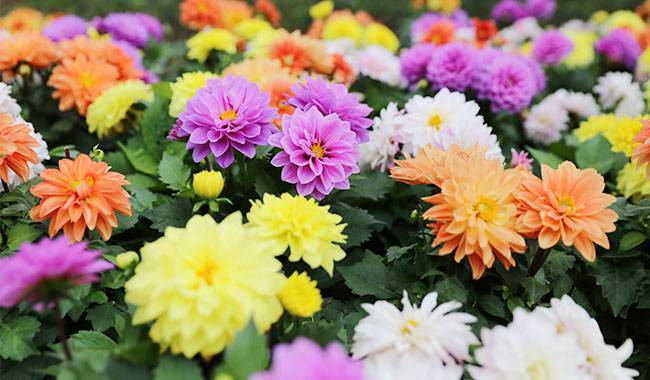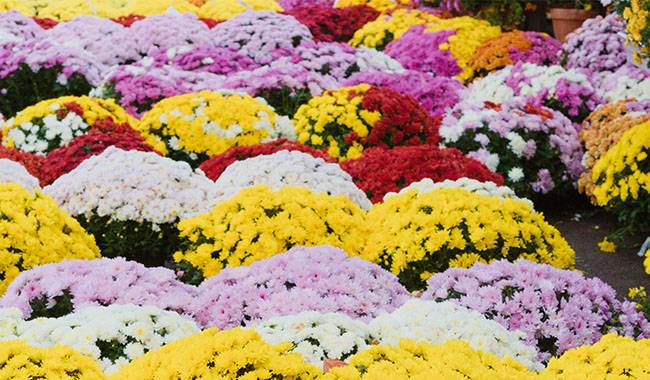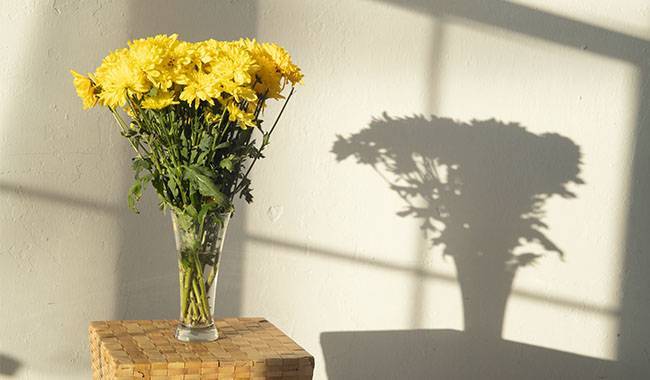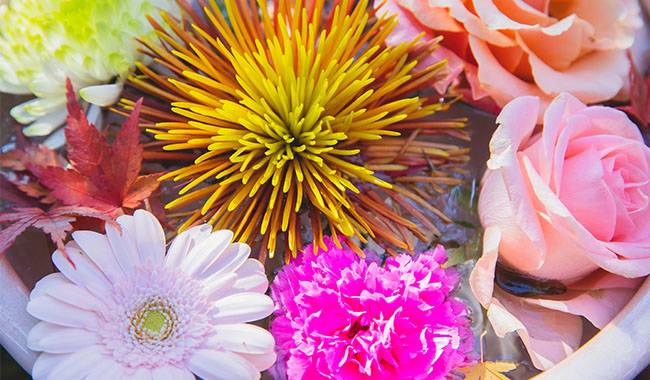
How to grow mums in pots? This article answers you among others the secrets!
It is impossible not to be enchanted by potted chrysanthemums. Huge “baskets” or spheres covered with so many flowers that they look almost like pillows fill the counters of markets and florists on the eve of autumn.
A more popular and widespread seasonal potted plant could not be found. Gardens and terraces, facades, and front gardens, balconies, and apartments are decorated with chrysanthemums. All potted chrysanthemums have one thing in common – low winter hardiness. It determines the specifics of the main solo growth in autumn.
LUSH BLOSSOMS IN BLOOM
Chrysanthemum is so popular at the end of the season, not only because the color combination perfectly presents the so-called autumn color collection. The colors of chrysanthemums do perfectly accentuate the autumnal color palette of scarlet and black.
However, no amount of color nuance can hide the importance of the endless blooming and extremely long flowering period, which is unique in its range and quantity. In addition, potted chrysanthemums are the most abundant in variety.
Potted chrysanthemums cannot withstand winter frosts and can be grown in two forms.
- A year-round indoor or balcony.
- A perennial plant that is kept indoors over the winter and cut back after the dormant period to stimulate growth.
Potted chrysanthemums can also be grown in the open – but then they need to be dug up and transferred to pots for overwintering. For this reason, they are more commonly grown as container crops.
Container-grown chrysanthemums are different from those in the garden. They develop into dense, cushion-shaped shrubs, formed by pruning and specifically bred to obtain specimens of increasing density.
The numerous shots are woody, dotted with simply carved foliage, and in most cases do not form a particularly impressive canopy, but simply serve as a backdrop for the flowers.
They produce so many flowers at the tips of the shoots that they form a solid cap.
The classic basket-shaped inflorescence of potted chrysanthemums can be simple or broad, or they can have rather narrow flowers with a few lobed petals.
All warm colors, including white and cream, yellow, orange, red, purple, and brown, can be monochromatic, combined, or even contrasting.
New blue chrysanthemums and novel green plants are in vogue today, as well as varieties with dazzling acrylic colors. Even more popular is a large color variety – a mix of globular, fuzzy, flowerless, which is all the warmer months to decorate the garden, while blooming throughout the fall and winter – in indoor culture.
Potted chrysanthemums come in a variety of sizes. When cultivating and growing indoors, choose miniature varieties up to 5.9inch (30cm) in height. However, specimens designed for open-air specimens are twice as large, sometimes reaching 3.2 feet (1 meter) in height and diameter.
Potted chrysanthemums come in both stems and adult balls, as well as squat and even separate. In short, there are many to choose from. House plants can bloom all year round, while garden chrysanthemums can be bought in the spring and put out purposely at extraordinary times.
But these early risers are just temporary decorations in the home and garden that will eventually be discarded. If you want to keep chrysanthemums, buy them in the typical flowering season – late summer and fall.
When buying, be sure to check exactly what conditions the chrysanthemums are used in and how they need to be grown: sometimes locally burned chrysanthemums require special care.
In order for potted chrysanthemums to really bloom, they will require simple but constant care and specific conditions.
They bloom lushly in cool temperatures, a requirement that can only be ignored if they are annuals or grown in the fresh air. Water and fertilize frequently, but otherwise there are usually no problems with chrysanthemums.
WHAT TO LOOK FOR WHEN BUYING
There are so many chrysanthemums on the market that it is not easy to choose a single shrub. But be very careful with your purchase, because your success really depends on how picky you are.
Never buy a chrysanthemum with fully open flowers; if the buds are less than half open, the blooms will last longer and be better.
Shrubs should be full in form, with strong, woody lower parts and healthy foliage. Watch out for yellowing leaves and spots on the leaves and shoots are a no-no.
IMPORTANCE OF OVERWINTERING
Chrysanthemums develop cyclically and have a period of complete dormancy. It is the difficulty of overwintering that causes many people to simply discard the plant at the end of the flowering period. If you can provide the right conditions, don’t let the plant die too soon.
If you want to keep your beautiful chrysanthemum in a pot and enjoy its blooms year after year, you must take care of proper overwintering.
Both miniature houseplants and true garden potted chrysanthemums need to be wintered in the same way (this is mainly why they are not separated into different groups). The dormant period begins immediately after flowering.
This is in large part why they are not separated into separate groups. The resting period begins immediately after fading.
The bushes need to be ruthlessly cut too short flax and immediately transferred to the coldest place where the temperature does not fall below 32°F (0°C), but will be as close as possible from 35-41°F (2-5°C). At the ideal temperature.
At this point, barely water or feed the chrysanthemums and leave them alone until they show the first signs of awakening.
As soon as the chrysanthemums start to grow, move them to a cool place and bright light, repot or replace the substrate, and start watering and fertilizing.
But that’s not all: in order for chrysanthemums to produce as many flowers next year, it’s best to be in a cool environment and during the flowering season. If the plant stands in a hot room, it will not produce an abundance of flowers.
HOW TO TAKE CARE OF POTTED CHRYSANTHEMUMS
Light rules
Chrysanthemums are crops that require only a short period of sunlight to produce abundant flowers. But this does not mean that they are content with a shaded position.
Chrysanthemums need the sunniest and brightest position throughout their active development, including flowering, where the plant will not be affected by the midday sun or will be shaded by adjacent potted plants.
In winter, chrysanthemums should be kept in a dark place (except for specimens that continue to bloom, which should be moved to the brightest place indoors and discarded after they are scheduled to bloom).
Temperature status
Potted chrysanthemums (either in the garden or indoors) prefer cooler temperatures, especially during the flowering stage. They are not the most heat-resistant crop and are only comfortable in typical autumn conditions.
The warmer the temperature, the faster the inflorescence blooms and the fewer new shoots the chrysanthemum produces. Therefore, you would be wise to keep even miniature houseplants outside while they are in bloom.
The optimum temperature for potted chrysanthemums is 50-68°F (10-20°C) or slightly higher. If the temperature is kept above 70-72°F (21-22°C) during the flowering period of chrysanthemums, they will not set buds properly for the next year’s flowering and will not achieve the desired results even in cold winters.
Watering
Autumn beauties need regular and fairly frequent watering. They do not like to be too wet, but they cannot stand to be dry either.
For optimal hydration, the excess water needs to be drained from the tray immediately after planting and the topsoil allowed to dry out before the next watering.
Humidity
More frequent watering makes up for the lack of need to moisten the air. To make the plant bloom more beautifully and to make the foliage more attractive and dense, you can sprinkle some chrysanthemums occasionally.
However, in doing so, water droplets must not accumulate on the buds and inflorescences, let alone make them very wet. The exception is chrysanthemums that bloom in rooms in winter, which need to compensate for the work of the central heating system.
Fertilization
Chrysanthemums need access to a very large amount of nutrients to produce such luxuriant flowers. The soil and the plants themselves are depleted, so these plants are fed almost like garden summer plants – very frequently.
It is best to reduce the amount of fertilizer, but the feeding itself should be done every 1-2 weeks. Once the signs of flowering appear, be sure to slowly reduce the frequency of fertilizer application. Stop adding fertilizer before overwintering. Resume fertilizer application 2 weeks after transplanting.
For chrysanthemums, for flowering plants, it is best to use a special fertilizer mixture or a general-purpose mixture. If you are using conventional fertilizers, apply more nitrogen during bush formation and more potassium and phosphorus as buds emerge.
Pruning and shaping
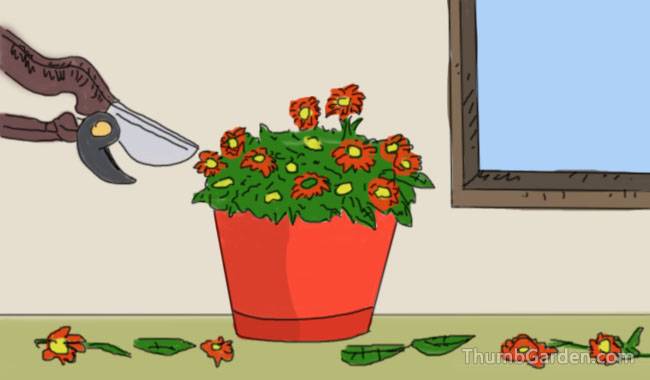
Potted chrysanthemums need to be pruned several times.
- Remove the faded inflorescence, which should be removed from the bush as soon as possible.
- Pruning the top of the tree to form a dense and compact crown should be done 2-3 times in spring and early summer.
- If you wish to limit the height of the bush or stimulate the second wave of flowering in winter – perform restrictive pruning of 1/3 of the shoots.
- Pruning before winter, prune the small stumps and remove all above-ground parts.
Substrate for potted chrysanthemums: any loose textured soil mix with sand and transfer (except acidic ones).
Transplanting time: once a year for perennial chrysanthemums, and every two years for old shrubs – immediately after the appearance of signs of growth in spring. Drainage is placed at the bottom of the container, the level of burial remains unchanged.
Propagation methods of potted chrysanthemums
- Seeds, which have a high germination rate, but require many years of seedling germination and a very long wait for flowering.
- Shrub division, by dividing old chrysanthemums in spring or after flowering.
- Through cuttings in spring or summer. Top cuttings are rooted in both soil and water. 2-3 specimens are required to be planted in one pot, initially pruned to 3.9-5.9inch (10-15cm), and then in the form of constant pruning as they grow to form a crown.
Common problems and diseases
- various rots that spread rapidly when the inflorescence is wet and over-watered.
- Lack of flowers or poor flowering due to temperature disturbance and poor feeding.
Control methods: Care correction
Potted chrysanthemums are used
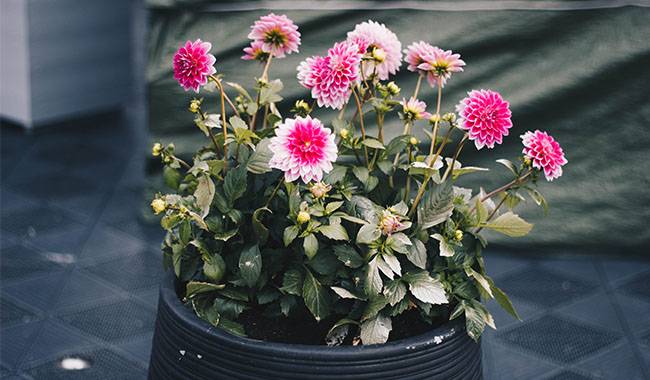
- Interior decoration, accents, and splashes of color in autumn and winter home decoration.
- spectacular guardian plants at gates, front doors, bend in paths.
- to create the interior of autumn terraces and recreational areas.
- to decorate autumn flower beds and squares, cover gaps and introduce beautiful flower accents in dull garden corners.
- To decorate garden seating areas in still life and decorative clusters.
- For decorating balconies and terraces.
Chrysanthemums love decorative and ornate containers, enjoy the company of other potted plants. And even in the messiest of gatherings, you will see it in the first place.





